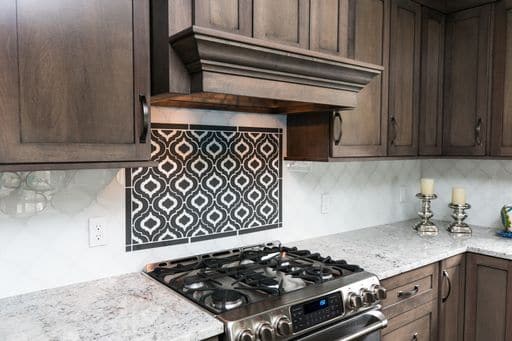Whether you’re replacing your backsplash as part of a complete kitchen remodel or simply refreshing your above-the-counter space, a new backsplash is a great investment. This update can transform the entire look of your kitchen—and it’s functional, too. The backsplash protects the wall behind the sink and underneath cabinets against water damage from splashing and spills.
Beyond its practicality, the kitchen backsplash is prime real estate for expressing your design style: Sophisticated. Contemporary. Eclectic. There are so many options for materials and installation designs/applications to suit any taste. But where do you begin?

How to Avoid Selecting the Wrong Kitchen Backsplash
A new backsplash can instantly upgrade your kitchen, but the wrong style or color can be an eyesore. Here are some best practices to make sure you select a backsplash that harmonizes with your space.
Identify your design style
Start by deciding the look you want to achieve in your kitchen. For a seamless flow throughout your home, the kitchen backsplash should complement or reflect your other living spaces. Tie in color or texture that you’ve repeated in different rooms. Or go neutral on your backsplash to allow accents to make a statement using rugs, window treatments, furniture, etc.
Establish a budget
This will rule out pricier product options from the start, making decision–making easier. For example, if you’re on a budget, you might avoid marble (costly) or an intricate mosaic design (additional installation time).
Do your homework
Narrow your backsplash material selections by researching projects on Pinterest and Houzz [link to Dover pages]. Visit tile stores like The Dover Flooring & Tile Center[LINK TO PAGE] to see and compare products first–hand. If you’re purchasing material from an online retailer, order a sample in advance of placing your order to make sure the product is of the right quality, color and texture.
Classics Never Go Out of Style
It’s not surprisig that porcelain tile is the most popular kitchen backsplash option.
Here’s why it’s a great choice: Ceramic or porcelain tile for a kitchen backsplash is the most popular option because it’s resilient, easy to clean and economical.
With today’s technology, tile options are no longer basic. Subway tiles continue to be a classic favorite—and they’re available in both standard and oversized formats, with a uniform, straight-edge finish or a handcrafted imperfect edge profile. Some feature a custom “watercolor effect” with a rich glazed finish.
PRO TIP: With the proper undercabinet lighting cascading over the tile, even a basic white porcelain tile can look dramatic. You don’t have to break the bank to achieve a stunning effect in your kitchen.
Kitchen Backsplash Trends You Need in Your Life
At Dover, we work closely with our vendors to offer the best in quality tile products—and we also keep an eye on trends.
Here’s what our customers are asking for right now:
Color
In addition to white porcelain subway tile, we also see classic subway tiles in various shades of blue, gray and green making their way to the front of the line.
Size
Variety is where it’s at in 2021. It used to be that 3” x 6” was the standard tile install. But now, tiles are available in 3” x 12” and 4” x 12” sizes (and many more). These larger-scale tiles make a dramatic design statement as a backsplash with wide or minimal grout lines.
Shape
Hexagon, honeycomb, linear, geometric shapes—we’re seeing it all right now with a mix of tile finishes and installation patterns like herringbone or vertical stack.
Finish
Matte finishes and textures like linen are also popular right now. Mixing same-color tiles—but in various textures and sizes—creates a stunning, monochromatic yet varied effect.
Pattern
Using patterned tiles across the whole backsplash or as inlays makes a design impact while leaving other elements, like counters and cabinets, neutral.
Composition
Glass, marble and other natural stone tiles are still on-trend. We see these tiles used to create focal-point mosaics incorporated as part of a larger backsplash design.
Installation
A tile backsplash should be installed from the counter to the cabinet base to create a sleek, continuous finish. To make the room feel larger, “tile walls” are on-trend: run tile from the counter, behind the range hood and up to the ceiling; and behind the sink, above the window to the ceiling. This installation also dresses up the cabinets and appliances.
Kitchen Backsplash Installation Tips
As with any home remodeling project, kitchen backsplash installations should follow product manufacturers’ guidelines for best results.
Get the right materials for the job
Consult a tile professional if you’re not sure about which adhesive or mortar you should be using. The correct setting material can make or break your project.
Measure twice. Cut once.
One mistake I often see homeowners make is they forget to account for electric outlets. They measure their space but don’t consider the required cuts for outlets, windows, etc. These tile cuts can be difficult to manage as a DIY project. Bear that in mind as you make your tile selections.
Know your limits.
Be mindful that if you’re going for an artistic look or working with a patterned or specialty-shaped tile, the install might be a bit more complicated.
Ready to dive into your kitchen backsplash remodel? We’re here to help – give us a call!
Tschaun Procaccini





